Menus
- The ultimate evolution of the 500 GP 2T 2000 World Grand Prix champion with KR Jr, Kenny Roberts Junior
- Like father, like son
- Head to Phillip Island
- Everything happens faster
- The subtleties of braking
- A very stable chassis
- Master the power
- Conclusion
The ultimate evolution of the 500 GP 2T 2000 World Grand Prix champion with KR Jr, Kenny Roberts Junior
Like father, like son
Mission accomplished. After winning four Grands Prix and finishing second in the overall standings of the 500 GP World Championship of the last millennium, Kenny Roberts Junior and the Suzuki RGV500 XR89 managed to do better in 2000.. KR Jr won the world title two races before the end of the championship after winning four more events in this 16-Grand Prix season, with only one retirement at Assen after the engine broke as junior appeared to be heading for a fifth success . A total of four pole positions, nine podiums and three fastest laps in the race crowned King Kenny II and the XR89 as the dominant crew of this new millennium, ahead of Valentino Rossi who was racing his first season with Honda. This success, the Suzuki rider obtained after taking the lead of the championship in the third race and having kept it throughout the season despite an obvious lack of power from the Suzuki engine on which Kenny was expressed a lot throughout the year. It just meant he had to work a little harder to succeed his father as master of the 500GP universe, exactly 20 years after KR Senior claimed his third and final world title with Yamaha….
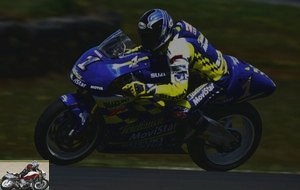 Kenny Roberts Junior Suzuki RGV500 XR89 review
Kenny Roberts Junior Suzuki RGV500 XR89 review
Head to Phillip Island
Two days after the Australian Grand Prix which marked the end of the season, I had the chance to test the new 500GP World Champion on the Phillip Island circuit. I had already had the opportunity to test the RGV500 in its XR89 form a year earlier in Jerez. But Jerez is a tighter track than the fast and intimidating Australian circuit. In Spain, I discovered the main strength of the bike: its smooth steering and precise handling, the result of the collaboration between Roberts, the Suzuki staff of Hamamatsu and the former pilot and racing engineer Warren Willing who endowed the XR89 with a particularly balanced chassis distinguishing it from its competitors. However, the ability to cut inward and maintain a tight trajectory in a slow turn was one thing in Jerez, but Phillip Island’s fast and smooth track was an opportunity to re-examine whether agility and the balance of the Suzuki in the change of direction were obtained at the cost of instability at high speed ?
Twenty-five laps on the island later, I had my answer, along with a lesson in the phenomenal skill levels needed to drive the ultimate evolution of the 500 2-stroke GPs at a competitive pace. However, two years later, these motorcycles would go down in history, replaced by 4-stroke heavier but no less demanding..
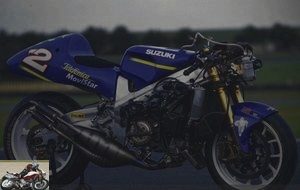 Suzuki RGV500 XR89 after the 2000 season
Suzuki RGV500 XR89 after the 2000 season
While in the past, testing Factory Superbikes at Phillip Island, I have always been able to pick up the pace pretty quickly and achieve a qualifying time for the WSBK race held at the same circuit, I have to admit. that trying to do the same with the lighter, but also powerful and infinitely better braked RGV500 presents a much steeper learning curve and takes a lot more time to master.
But I was in good company alongside former World Champion Kevin Schwantz who took over the handlebars of a 500 for the first time in 5 years. Imagine that even he was seven seconds behind the times of King Kenny II and his new Spanish teammate Sete Gibernau (who discovered the Suzuki in the same pit as me). whoops !
Everything happens faster
It’s not for lack of trying, but once you’ve programmed your brain to convince yourself that what appears to be a suicidal entry speed for the Siberia curve, just after a perfect pass through the Honda Corner , we realize that this is the right approach to pilot this more or less guided missile that represents a 500 GP. The difference with a Superbike is in the weight, or more precisely in the power to weight ratio, which makes everything seem to happen much faster. Yet these two very different types of motorcycles were tied for the lap record at Phillip Island at the time..
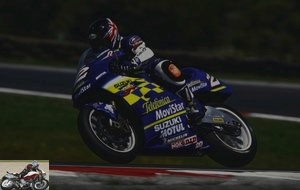 It is on the Phillip Island route that we tested the RGV
It is on the Phillip Island route that we tested the RGV
On a 162 kg Superbike, one has at least the impression of being more or less in control, able to use the power of the same level, but more flexible delivered by the four-stroke engine and above all to make use of the more controllable combination of engine brake and metal discs with more confidence when braking at high speed than with composite carbon brakes and the minimum engine brake of the 132 kg missile.
But on the RGV 500, although the top speed of over 300 km / h is currently slower than many factory Superbikes of the time, the latter is reached much faster. In doing so it is even more crucial to choose the right trajectory, almost instinctively, through the rapid curves that follow one another at Phillip Island, because the ideal trajectory narrows much faster under such explosiveness when accelerating, so we have a lot less time and even less space to make corrections.
I experienced this after Siberia when, thanks to the Suzuki’s excellent propulsion even on the corner, I got out of the curve so well that I missed the braking for the next right to Hayshed and got into started too far into the turn which in turn got me wrong for everything else up to Lukey Heights. There I was effortlessly passed by Kenny Roberts himself, with a nod of pity, before he gave me a demonstration on how to stop for the MG hairpin bend right after. It happened after another lesson in my previous session where I was too busy complimenting myself on the late braking I did in the first Doohan Corner turn, waiting for the 150m sign at the end of the main straight line to go down two gears and brake copiously … when KR appeared, still throttle wide open on the last gear !
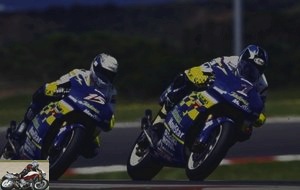 It can be frustrating to see a world champion like this tumble out of a corner
It can be frustrating to see a world champion like this tumble out of a corner
Kenny roberts junior :
I did a lap in 1’31 here, but only not braking at all for the first corner. I just go down two gears at the 100 sign and reduce the speed of the tire. Ok, it takes a while to get there, but that’s one of the main advantages of the Suzuki: cornering speed. It is also our big handicap, because we have less horsepower than Honda and Yamaha. So if we get ahead of them, we have a chance to win. But if a Honda rider finds himself in front of us, every time he puts the throttle on, he widens the gap. I can take anyone braking on the Suzuki, but not if they start 20 meters late due to the lack of power.
Unless you don’t brake at all in some corners, of course…
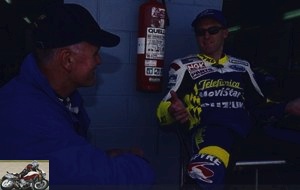 Roberts’ secret? Do not brake in certain turns
Roberts’ secret? Do not brake in certain turns
The subtleties of braking
Even at my slower pace on the Suzuki, I could appreciate how well it maintains its speed in the corners. There is also that good feeling of the Ohlins fork adopted by the team in the middle of the 1999 season and ideally installed to offer a lot of feedback from the 17 "Michelin front tire that the team has always ridden with, rather than the 16.5 "preferred by other teams. But the lessons in maintaining momentum aside, it was the high speed braking that took the longest to master on the RGV 500. This is definitely where I lost the most time..
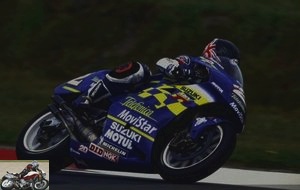 However, it is not easy to apply the advice to the letter.
However, it is not easy to apply the advice to the letter.
The year before in Jerez, it was one aspect of the bike that I found questionable, its lack of stability on hard braking. This point was even commented on by some of Kenny’s rivals, including previous champion Alex Criville. At Phillip Island a year later, that braking became the obstacle to improving my lap times, mostly because I had to relearn all of my Superbike braking benchmarks to adjust to efficiency. Brembo carbon brakes. Manufactured by the Italian company from a Mitsubishi composite material that retains heat for longer and thus ensures a better feeling at the lever as well as super efficient stopping at high speeds, while being more durable.
Eugenio Gandolfi, Brembo technician:
“The Suzuki team only consumed three sets of discs per bike over the season. But we preferred that they use smaller 290mm discs at Phillip Island, as they do on several other tracks to help the disc. to maintain its temperature in colder conditions. Only Kenny prefers the 320mm rotors for their extra performance at the various heavy braking points here in Australia. "
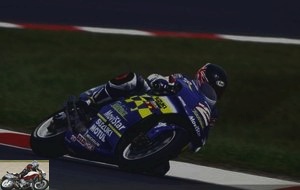 Brembo carbon brakes are formidable efficiency
Brembo carbon brakes are formidable efficiency
A very stable chassis
The Suzuki’s performance chassis proved just as forgiving on a fast track like Phillip Island as it did on a slower track like Jerez. It always changes direction just as well and stays balanced as it swiftly passes over the ripples as it exits Siberia, effortlessly ignoring their effects and maintaining course. At the next right-hand turn, however, it is preferable to take a lower gear than expected to stay in the traj, with the engine singing at high speed, but at the end of the torque curve. A gear above this has the effect of pushing the front wheel and forcing it to slow down to correct the shot. At high speeds the Suzuki is very balanced, only shaking its head once per turn over the big bump in turn 12 leading to the Gardner straight, but this is probably due to adjusting the rear shock a little too much. soft for my extra weight compared to Kenny.
Elsewhere, the XR89’s chassis is ultra-stable. But if you apply the brakes to correct your entry speed once on the angle and into the turn, the bike straightens up and pulls straight. The Suzuki thus rewards a clean and precise driving style of the GP 250 type such as the one in which KR Junior excels and which allowed me to keep speed in curves by taking a lot of angle thanks to the grip of the sides of the rear Michelin. 16.5 "on the acceleration. The fact that I discovered it by mistake after missing my braking point for Turn 2 and had to take the Southern Loop at a speed that seemed suicidal to me is of course totally suicidal. irrelevant. In the next round, I went back just as quickly, but this time on purpose… !
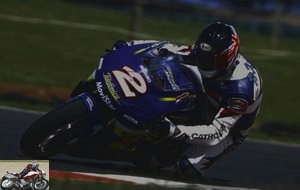 The Suzuki is able to maintain excellent cornering speed, but leaves no room for guesswork.
The Suzuki is able to maintain excellent cornering speed, but leaves no room for guesswork.
The only time the chassis of the XR89 seems jittery is on very hard braking, especially on the descent to the MG hairpin, when the extra weight transfer due to gravity makes an already awkward situation worse. Although Kenny Robert said he used the rear brake first to counter this, it seems really difficult, especially compared to the more balanced handling of Valentino Rossi’s Honda NSR500 which I rode the following month in Jerez. Ironically, it’s even more evident in the Honda curve where I shifted to fifth at high speed in the previous Stoner Corner before braking very, very hard on the angle again to take the hairpin just after..
Master the power
The dreaded bite of the carbon brakes, coupled with the bike’s momentum, lifts the rear wheel as I try to straighten the Suzuki, causing it to ripple as it already winds under braking, making it very difficult. to put on the right path and follow it. Twice I chickened out, losing my confidence in the Michelin’s ability to front and speeding the corner into the wrong lane, before taking the spare lane. In fact, I’ve been there three times, the third after forgetting to open the fuel valve before jumping off for my second session, which brought the V4 engine to a standstill..
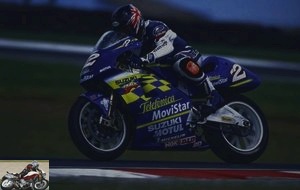 The XR89 is less brutal than the Honda NSR in its way of delivering power
The XR89 is less brutal than the Honda NSR in its way of delivering power
It was on this same engine that the biggest improvement was made between the bike I had ridden a year earlier and this one. Maximum power had been greatly improved and the transition to medium revs around 10,500 rpm had been strengthened and smoothed. Compared to the Honda’s steeper horsepower at the same revs, the Suzuki engine here is more accommodating, but not as powerful as that of the NSR. We can say that it is better at the bottom than the Honda since coming out of the MG hairpin I can briefly switch from first to second around 10,000 rpm before taking it to the next long left while playing on the accelerator to steer it cleanly and pick up speed as the lane opens. This allowed me to take advantage of the revised Suzuki 2000 portage and electronically controlled variable-size exhausts to avoid a rather bumpy low-revving when the rear wheel stalled slightly..
The powershifter speed change is really well set. I must admit, however, that I did not pay much attention to the row of 5 red leds which light up successively above the analog meter. I was far too busy holding the bike firmly while the front wheel palpated the air and desperately tried to persuade my brain to follow the dreaded acceleration of a 500 GP two-stroke. Remembering what Warren Willing told me a year earlier, I put an end to the wheelies at the exit of Siberia by going up in the revs so that the engine comes out of the torque curve, which paradoxically ensures a better drive than using maximum torque around 11,500 rpm. It was also better for my heart rate. At least I can see where I’m heading the bike for the next turn, without landing on the front wheel with the handlebars turned as I try to spin the bike with the wheel up…
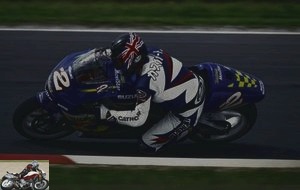 It’s already time to return the RGV500 to its owner
It’s already time to return the RGV500 to its owner
Conclusion
King Kenny II may have had his work cut out for his world crown in 2001, after Suzuki suspended two-stroke R&D in favor of its four-stroke MotoGP project. But he came out on top in 2000 on a Suzuki that turned out to be the best package on the grid, just as his father had done 20 years earlier on a similarly powered Yamaha. Like father, like son…
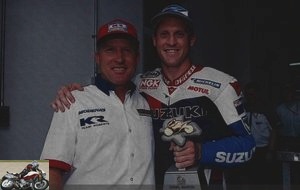 For the Roberts, being 500GP world champion is a family tradition
For the Roberts, being 500GP world champion is a family tradition
Strong points
- Agility
- Maneuverability
- Braking power
- Acceleration
Weak points
- Braking stability
- Top speed
Suzuki RGV 500 XR89 technical sheet
Related articles
-
Yamaha YZR500 OW48R motorcycle test
Kenny Roberts’ 3rd title bike in 1980 4 cylinders in line, 2-stroke, 498 cm3, 102 hp, 135 kg This is the year of the pyramids in motorcycles, with a good…
-
OJ Yamaha YZR250 OWL5 motorcycle test
The 2000 GP250 World Champion 90 ° V-twin, 249 cc, 97 hp, 268 km / h, 97 kg In 2000, Olivier Jacque dazzled Grand Prix enthusiasts riding the Yamaha of…
-
French watch or Gallic genius ? 128 hp Honda Moto2 engine, parallelogram suspension front axle, adjustable geometry, solid 7075 T6 aluminum chassis, 154…
-
Kawasaki ZZR 1400 motorcycle test
The Very High Speed Motorcycle according to Kawasaki We do three kilometers at 200 then at my signal, we open wide. Sitting next to me, assayer Kawa…
-
Suzuki GSX-R 750 motorcycle test
Out of category champion A true modern icon of motorcycling sport, the 750 GSXR pursues its solo career, without however ever visiting the paddocks or…
-
Suzuki GSX-R 1000 motorcycle test
A friend who wants you well First appearing in 2000, the GSXR 1000 will quickly establish itself as a sporting stallion for a long time. But in the face…
-
Suzuki Bandit 650 N motorcycle test
Released for good behavior Appeared in 1995, the Bandit has continued to evolve, going from the first nasty roadster to a beefy roadster but leaving…
-
Honda CB1100R T-Rex motorcycle test
The best Post-Classic sports car ever built 4 cylinders in line, 1,156 cm3, 145 hp, 160 kg, Harris frame, 273 km / h A T-Rex is big, strong, powerful ……
-
Triumph Speed Triple R 1050 motorcycle test
A top-class Speed Triple From the luxury spokes from Ohlins for the suspensions, Brembo for the monobloc calipers and PVM for the forged wheels, the…
-
Japanese legend, successor to the GSX1100S Katana 4 cylinders in line, 999 cm3, 150 hp, 108 Nm, 215 kg full made, 13,699 euros The Katana is a very old…
Thank you very much Alan … I enjoy this wonderful essay / article / review with delight, having my morning coffee.
Too bad I’m so far from the paddocks! Finally, it must have been a time "still" blessed by the gods! Thank you, biker !
not agree on the price level with the gS
the honda is not really cheaper with equal equipment!
the gs also offers the shifter, the keyless start, auto suspensions adjustable according to the weight (not the honda), a telelever system, a gimbal, a single-arm, the handlebar warning system, a 1250 engine and not 1100 with 136 hp instead of 100, and it’s not the same ,
the gs does not have cornering lighting, with the 3 packs the gs is 20,400 euros but has more options and a bigger and more powerful engine and when you know that the engine is almost half the motorcycle price!
I can no longer find a big difference, before yes, now no.
@Perso, the electronic suspensions and the shifter are optional on the Africa and its suspensions have nothing to envy the BM even if it does not have telelever which is a BM patent history to say that they have that.
It’s like the GS Shiftcam which is just a copy of the VTEC system that Honda has been using for years (except on the Africa Twin because the engine must be simple and removable by a little mechanic at the end of the world …)
In addition 100hp is more than enough for trail running, on the GS the TT mode limits precisely to 100hp.
And the Africa has its 21 wheel for the TT against 19 on the GS.
The keyless start, we already blame the Africa that it has too many electronics so you have to know what you want. 😉
The gimbal apart for those who do not want to lubricate the chain it is not a blocking point in itself.
The single-sided arm is only used for a lighter gimbal and therefore useless if you have chosen a chain.
So yes the Honda is cheaper even with the options.
The difference with especially that the GS is more made for the bitumen while the Africa is more made for the earth.
Subjective point, I find Africa much more beautiful.